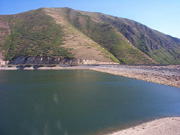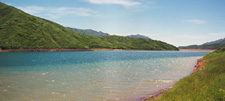Bulletin Board
Reservoir Levels Drop
Northern Utah Reservoirs are impacted by the drier and warmer summer of 2000
September 14, 2000
As the autumn leaves begin to change in the mountains, water managers are assessing the amount of water remaining in the various reservoirs in northern Utah. It’s been a hot, dry summer, placing
enormous demand on the stored water supply for urban dwellers and farmers along the Wasatch Front. Forty consecutive days of 90 degrees or better temperatures neared an all-time record. Only
surpassed by the string of 50 days in 1967, the summer of 2000 placed second. Besides the warm temperatures, the summer was nearly without precipitation.
Deer Creek Reservoir water level will be down 27 feet at the end of the water year.

The amount of water stored during the spring run off was below normal because of lower than normal snowpack and subsequently lower run-off quantities. According to the Colorado Basin River Forecast Center, water year precipitation at the end of April 2000 was 75 percent of normal and most of the snow had melted. Stream flows were predicted to be about 55 percent of normal in the Weber Basin and 60 percent in the Utah Lake drainage. Local canyon streams along the Wasatch were about 70 percent of normal. Reservoir managers were hopeful that the reservoirs would fill, but the dry spring only filled northern Utah's reservoirs to an average of 88 percent of capacity.
The Weber Basin Water Conservancy District (WBWCD) delivers water to users in Weber and Davis Counties from seven storage reservoirs with a usable capacity of 378,828 acre-feet. During the spring, Ivan Flint, Chief Executive Officer and General Manager, thought his district’s reservoirs would fill, but the watershed soils were so dry, much of the water disappeared into the ground before it reached the reservoirs. The first sign that the flows were going to below normal was the clarity of the water. Flint said, “Normally the water becomes turbid during run-off, but this spring the water remained clear.”
The Weber Basin Project stores a 2-year water supply, so there was adequate water supply to provide all of the district’s customers a full allotment of water. “However, as the summer progressed, the district’s policy of requiring secondary water users not to water between the hours of 10 am and 6 pm was more strictly enforced to save water,” says Flint. “Water usage was very high this year. For example the municipal water system was at peak capacity at the end of June.” Despite a full allocation of water, some farmers ran out of water before the irrigation season ended. WBWCD's total water supply in a normal year amounts to 207,000 acre-feet with 74 percent used for agricultural irrigation and the remaining 26 percent used for municipal and industrial water supply.
|
|
Like WBWCD, the Association allocated a full allotment to its shareholders, including the Metropolitan Water District of Salt Lake and Sandy (MWDSL&S). Even with full allotments, some farmer shareholders have run out of water before the end of the irrigation season. MWDSL&S may use its full allotment before the end of the water year. Deer Creek is expected to drop 27 feet from the overflow level by the end of the season.
|
|
Little Dell Reservoir, the largest storage project within Salt Lake County, stored only a scant 3,000 acre-feet of new water this year, excluding water diverted directly through Mt. Dell Reservoir. The Parleys drainage received considerably less than normal snow during the winter months. As of January 1, 2000, Little Dell held about 10,900 acre-feet of carry-over water and by late May reached its maximum storage level of only 14,000 acre-feet. Storage is expected to be around 6,000 acre-feet by the end of September in this usable 17,500 acre-foot facility.
Both Flint and Denos are relying on a normal winter to replenish the water in their reservoirs. Flint notes that the Weber Basin Project is designed as a two-year storage project. "This year we cut into the two-year supply and expect to have only a 40 percent carryover instead of 50 percent," says Flint. "Not exactly where we want to be." Denos will carry over 50, 000 acre-feet of water into the next water year. But he's optimistic about the coming winter, "Everybody from high tech to the Farmers' Almanac are predicting a normal winter." But fudging a bit, both Flint and Denos plan to invest in a cloud seeding program this winter to help ensure a normal winter snowpack in order to fill those lower than normal reservoirs next spring.
Related links:
Conjunctive Water Management: www.slcclassic.com/utilities/news080100.htm
Wasatch Dry Spell: www.slcclassic.com/utilities/news05192000.htm

